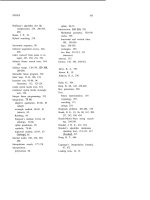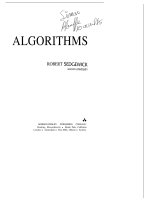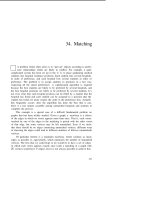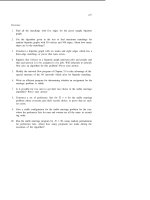Tài liệu Thuật toán Algorithms (Phần 12) ppt
Bạn đang xem bản rút gọn của tài liệu. Xem và tải ngay bản đầy đủ của tài liệu tại đây (82.06 KB, 10 trang )
9. Quicksort
In this chapter, we’ll study the sorting algorithm which is probably
more widely used than any other, Quicksort. The basic algorithm was
invented in 1960 by C. A. R. and it has been studied by many people
since that time. Quicksort is popular because it’s not difficult to implement,
it’s a good “general-purpose” sort well in a variety of situations), and
it consumes less resources than any other sorting method in many situations.
The desirable features of the Quicksort algorithm are that it is in-place
(uses only a small auxiliary stack), requires only about operations
on the average to sort items, and has an extremely short inner loop.
The drawbacks of the algorithm are that it is recursive (implementation is
complicated if recursion is not available), has a worst case where it takes
about operations, and is fragile: a simple mistake in the implementation
might go unnoticed and could cause it perform badly for some files.
The performance of Quicksort is very well understood. It has been
subjected to a thorough mathematical analysis and very precise statements
can be made about performance issues. The analysis has been verified by
extensive empirical experience, and the algorithm has been refined to the
point where it is the method of choice in a broad variety of practical sorting
applications. This makes it worthwhile to look somewhat more carefully at
ways of efficiently implementing Quicksort than we have for other algorithms.
Similar implementation techniques are appropriate for other algorithms; with
Quicksort we can use them with confidence because the performance is so well
understood.
It is tempting to try to develop ways to improve Quicksort: a faster
sorting algorithm is computer science’s “better mousetrap.” Almost from the
moment first published the algorithm,
“improved” versions have been
appearing in the literature. Many ideas have been tried and analyzed, but
it is easy to be deceived, because the algorithm is so well balanced that the
103
104
CHAPTER 9
effects of improvements in one part of the program can be more than offset by
the effects of bad performance in another part of the program. We’ll examine
in some detail three modifications which do improve Quicksort substantially.
A carefully tuned version of Quicksort is likely to run significantly faster
than any other sorting method on most computers. However, it must be
cautioned that tuning any algorithm can make it more fragile, leading to
undesirable and unexpected effects for some inputs. Once a version has been
developed which seems free of such effects, this is likely to be the program to
use for a library sort utility or for a serious sorting application. But if one is
not willing to invest the effort to be sure that a Quicksort implementation is
not flawed, Shellsort is a much safer choice and will perform adequately for
significantly less implementation effort.
The Basic Algorithm
Quicksort is a “divide-and-conquer” method for sorting. It works by partition-
ing a file into two parts, then sorting the parts independently. As we will see,
the exact position of the partition depends on the file, so the algorithm has
the following recursive structure:
procedure integer);
var i;
begin
if then
begin
quicksort (1, i- 1)
r);
end
end
The parameters and delimit the within the original file that is to
be sorted: the call N) sorts the whole file.
The crux of the method is the partition procedure, which must rearrange
the array to make the following three conditions hold:
(i) the element a[i] is in its final place in the array for some i,
(ii) all the elements in . . are less than or equal to
(iii) all the elements in . . .,a[r] are greater than or equal to
This can be simply and easily implemented through the following general
strategy. First, arbitrarily choose to be the element that will go into
105
its final position. Next, scan from the end of the array until finding
an element greater than and scan from the right end of the array until
finding an element less than The two elements which stopped the scans
are obviously out of place in the final array, so exchange them.
(Actually, it turns out, for reasons described below, to be best to also stop the
scans for elements equal to even though this might seem to involve some
unnecessary exhanges.) in this way ensures that all array elements
to the left of the left pointer are less than and array elements to the right
of the right pointer are greater than a [r] . When the scan pointers cross, the
partitioning process is nearly complete: all that remains is to exchange
with the leftmost element of the right
The following table shows how our sample file of keys is partitioned using
this method:
1
2 3 4 5 6 7 8 9 10 11 12 13 14 15
A 0 R T
A A M P
A A E
AA INGOXSMPLR
The rightmost element, E, is chosen as the partitioning element. First
the scan from the left stops at the then the scan from the right stops at the
A, then these two are exchanged, as shown on the second line of the table.
Next the scan from the left stops at the 0, then the scan from the right stops
at the E, then these two are exchanged, as shown on the third line of the
table. Next the pointers cross. The scan from the left stops at the R, and
the scan from the right stops at the E. The proper move at this point is to
exchange the E at the right with the R, leaving the partitioned file shown on
the last line of the table. The sort is finished by sorting the two on
either side of the partitioning element (recursively).
The following program gives a full implementation of the method.
106 CHAPTER 9
procedure integer)
var v, t, i, j: integer;
begin
if then
begin
repeat
repeat until a[i]>=v;
repeat until
t:=a[i];
until j<=i;
i-l);
end
end;
In this implementation, the variable v holds the current value of the “partition-
ing element” and i and j are the left and right scan pointers, respectively.
An extra exchange of a[i] with a is done with j<i just after the pointers cross
but before the crossing is detected and the outer repeat loop exited. (This
could be avoided with a The three assignment statements following that
loop implement the exchanges with (to undo the extra exchange) and
a[i] with (to put the partitioning element into position).
As in insertion sort, a sentinel key is needed to stop the scan in the
case that the partitioning element is the smallest element in the file. In this
implementation, no sentinel is needed to stop the scan when the partitioning
element is the largest element in the file, because the partitioning element
itself is at the right end of the file to stop the scan. We’ll shortly see an easy
way to avoid having either sentinel key.
The “inner loop” of Quicksort consists simply of incrementing a pointer
and comparing an array element against a fixed value. This is really what
makes Quicksort quick: it’s hard to imagine a simpler inner loop.
Now the two are sorted recursively, finishing the sort. The
following table traces through these recursive calls. Each line depicts the result
of partitioning the displayed using the boxed partitioning element.
QUICKSORT
107
1
2 3 4 5 6 7 8 9 10 11 12 13 14 15
ASORTI NGEXAMPLE
NGOXSMPLR
A
A A
L IN G 0 P T S
L
G I L
I
N P 0
0 P
P
S T X
AAEEGI LMNOPRSTX
Note that every element is (eventually) put into place by being used as a
partitioning element.
The most disturbing feature of the program above is that it runs very
inefficiently on simple files. For example, if it is called with a file that is already
sorted, the partitions will be degenerate, and the program will call itself N
times, only knocking off one element for each call. This means not only
that the time required will be about but also that the space required
to handle the recursion will be about N (see below), which is unacceptable.
Fortunately, there are relatively easy ways to ensure that this worst case
doesn’t occur in actual applications of the program.
When equal keys are present in the file, two subtleties become apparent.
First, there is the question of whether to have both pointers stop on keys









